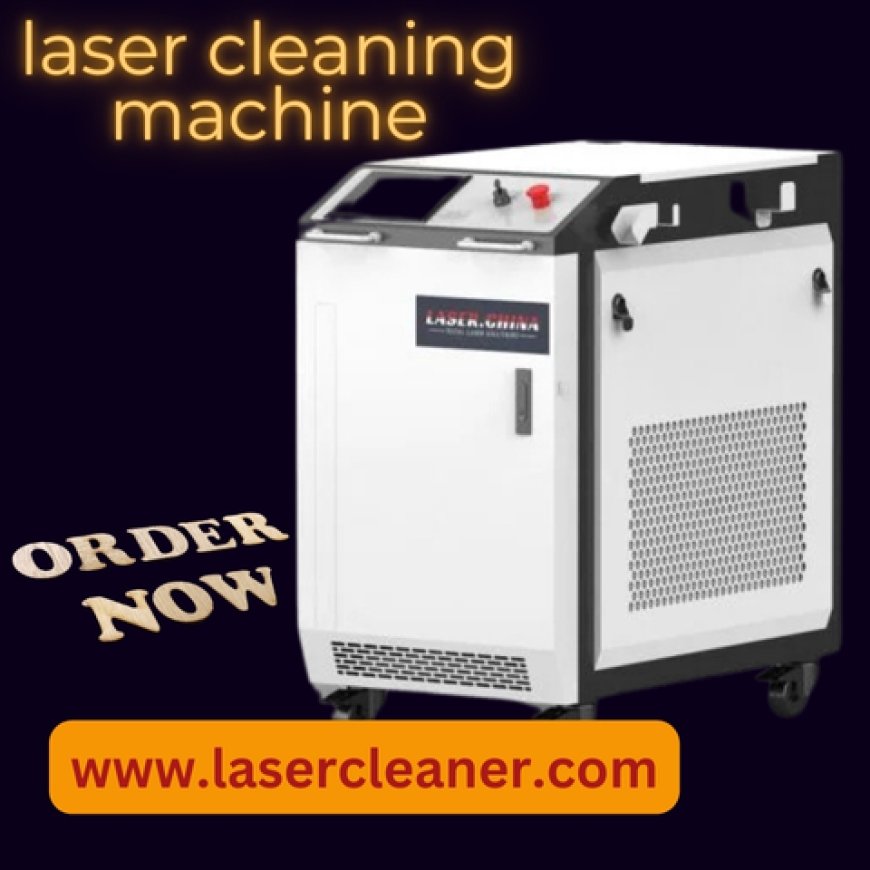The Power of Precision: Exploring the Role of the Laser Cleaning Machine in Modern Industries

At first glance, one might wonder how a tool that doesnt rely on chemicals, water, or abrasives can outperform traditional methods. After all, how can a light beam provide industrial-grade cleaning power? The answer lies in precision, speed, and controlthree qualities that define the operation of a laser cleaning machine.
What Is a Laser Cleaning Machine?
A laser cleaning machine is a non-contact tool that uses focused laser beams to remove unwanted substancessuch as rust, paint, oxide, oil, and residuefrom surfaces. The laser beam is directed at the contaminated surface, where it interacts with the top layer of unwanted material. This material absorbs the laser energy, rapidly heats up, and is ejected or vaporized, leaving the underlying substrate intact.
The core principle is simple yet incredibly effective. The laser beam targets the contaminants with such precision that it eliminates the need for brushing, grinding, or blasting. Since there is no need for abrasives, water, or chemicals, the process is dry, clean, and eco-friendly.
The Science Behind Laser Cleaning
To understand why a laser cleaning machine can deliver such impressive results, it helps to explore the science at play. The process is governed by photothermal and photomechanical interactions.
When the high-energy laser beam strikes the target, two things happen:
-
Photothermal Reaction The contaminant absorbs the energy and heats up very quickly. The sudden temperature rise causes the particles to expand and eventually vaporize or explode off the surface.
-
Photomechanical Shock In some applications, the energy is delivered in pulses. This creates shock waves that mechanically break the bond between the surface and the contaminant layer, causing debris to lift away.
The substrate itself reflects most of the lasers energy (if properly calibrated), ensuring no damage to the base material. This makes laser cleaning ideal for delicate surfaces like artwork, heritage monuments, and even intricate machinery.
Where Laser Cleaning Machines Are Making an Impact
1. Manufacturing and Automotive Industries
In assembly lines, maintaining cleanliness before welding or coating is crucial. A laser cleaning machine ensures that oils, oxides, and residues are removed without introducing any moisture or secondary waste, making the surface instantly ready for further processing.
In the automotive industry, the machine is used for pre-treatment before welding car body panels, removing rust from old parts, or stripping paint from specific components during rework or maintenance.
2. Aerospace and Defense
In aerospace, surface integrity is non-negotiable. Contaminants left behind before bonding, coating, or inspection can compromise the components performance. Laser cleaning provides controlled removal of corrosion, carbon deposits, or old coatings without degrading the base material or affecting weight-sensitive parts.
3. Heritage Restoration
Perhaps one of the most visually compelling uses of a laser cleaning machine is in the restoration of sculptures, frescoes, and historic monuments. Since it doesnt require water or physical contact, fragile materials like sandstone or ancient pigments remain unharmed while surface grime and pollutants are carefully removed.
4. Shipbuilding and Marine Equipment
The marine industry regularly combats rust, barnacles, and salt deposits. A laser cleaning machine offers a powerful solution to clean ship hulls, propellers, and mechanical parts with high precision, reducing maintenance time and increasing the lifespan of vital components.
Precision Without Pollution
A common question often raised is: "If a laser cleaning machine doesnt use chemicals, water, or grit, where does the dirt go?" This is where the non-invasive brilliance of the machine comes into play.
During the cleaning process, the unwanted material is either vaporized or transformed into microscopic particulates. Most setups include a vacuum system or fume extractor, which captures these particles and filters them. The result? A clean workspace with no runoff, sludge, or chemical residue.
This approach aligns with increasingly strict environmental regulations across industries and makes the laser cleaning machine a forward-thinking investment for companies seeking compliance and sustainability.
Operational Flexibility
Another compelling aspect is how easily a laser cleaning machine can be integrated into both manual and automated workflows. Whether its a portable handheld unit for field use or a fully automated robotic cell within a manufacturing plant, laser cleaning adapts effortlessly.
Operators can adjust power levels, pulse durations, scanning speeds, and focal lengths depending on the job. Some surfaces may require gentle passes to remove soot without scratching, while others might need high-energy pulses to tackle deeply embedded corrosion.
In either case, the machine allows for full controlunlike traditional cleaning tools that often rely on brute force or harmful solvents.
Economic Considerations: Investment vs. Waste
Theres no denying that the upfront cost of a laser cleaning machine can appear significant when compared to sandblasters or chemical baths. However, the long-term savings often outweigh the initial expense.
Heres how:
-
No consumables like sand, soda, or chemical agents are needed.
-
Minimal maintenance due to fewer moving parts and no abrasive wear.
-
Faster turnaround reduces labor hours and increases production cycles.
-
Improved safety means fewer workplace incidents and compliance fines.
-
Better surface results enhance product quality and reduce rework.
The value proposition becomes even more convincing when companies factor in the costs associated with waste disposal, chemical handling, ventilation, and environmental auditsnone of which are required when using a laser cleaning solution.
Safety and Skill Requirements
While the laser cleaning machine simplifies many tasks, it still demands responsible usage. Operators must be trained to handle laser radiation, understand focal distance settings, and ensure that the surface material is compatible with the beams wavelength.
Facilities must adhere to safety standards that include proper enclosure designs, warning systems, and the use of laser safety glasses. The good news is that many modern machines come with built-in interlocks, emergency shut-offs, and intuitive user interfaces that streamline training and operation.
Final Thoughts
The rise of the laser cleaning machine is not just a technological trendits a logical response to the limitations and risks of traditional surface cleaning methods. In a world that values precision, cleanliness, and sustainability, this technology stands out as a reliable partner across industries.
From heavy-duty manufacturing to delicate artifact restoration, the versatility and control offered by laser cleaning are reshaping how we think about maintenance, preparation, and preservation. As environmental standards tighten and industries push for leaner operations, the adoption of this powerful tool is likely to accelerate further.
Its not just about cleaning betterits about cleaning smarter. And in that race, the laser cleaning machine is lighting the way forward.








































